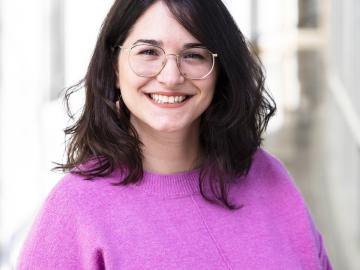Filter News
Area of Research
- Advanced Manufacturing (19)
- Biological Systems (16)
- Biology and Environment (143)
- Biology and Soft Matter (5)
- Building Technologies (5)
- Chemical and Engineering Materials (3)
- Chemistry and Physics at Interfaces (11)
- Clean Energy (349)
- Climate and Environmental Systems (9)
- Computational Biology (5)
- Computational Chemistry (5)
- Computational Engineering (3)
- Computer Science (8)
- Data (1)
- Earth Sciences (1)
- Electricity and Smart Grid (2)
- Energy Frontier Research Centers (14)
- Energy Sciences (3)
- Fossil Energy (2)
- Fuel Cycle Science and Technology (3)
- Functional Materials for Energy (16)
- Fusion and Fission (49)
- Fusion Energy (9)
- Geographic Information Science and Technology (3)
- Isotope Development and Production (1)
- Isotopes (29)
- Materials (343)
- Materials Characterization (2)
- Materials for Computing (26)
- Materials Synthesis from Atoms to Systems (13)
- Materials Under Extremes (12)
- National Security (69)
- Neutron Data Analysis and Visualization (2)
- Neutron Science (151)
- Nuclear Science and Technology (54)
- Nuclear Systems Modeling, Simulation and Validation (1)
- Nuclear Systems Technology (1)
- Quantum Condensed Matter (4)
- Quantum information Science (6)
- Reactor Technology (1)
- Renewable Energy (2)
- Sensors and Controls (3)
- Supercomputing (267)
- Transportation Systems (9)
News Type
Date
News Topics
- 3-D Printing/Advanced Manufacturing (81)
- Advanced Reactors (18)
- Artificial Intelligence (67)
- Big Data (31)
- Bioenergy (70)
- Biology (75)
- Biomedical (44)
- Biotechnology (16)
- Buildings (31)
- Chemical Sciences (47)
- Clean Water (15)
- Climate Change (67)
- Composites (15)
- Computer Science (135)
- Coronavirus (34)
- Critical Materials (11)
- Cybersecurity (32)
- Decarbonization (59)
- Education (3)
- Element Discovery (1)
- Emergency (2)
- Energy Storage (70)
- Environment (139)
- Exascale Computing (32)
- Fossil Energy (4)
- Frontier (35)
- Fusion (40)
- Grid (37)
- High-Performance Computing (67)
- Hydropower (5)
- Irradiation (1)
- Isotopes (40)
- ITER (4)
- Machine Learning (32)
- Materials (102)
- Materials Science (90)
- Mathematics (5)
- Mercury (9)
- Microelectronics (2)
- Microscopy (36)
- Molten Salt (3)
- Nanotechnology (44)
- National Security (48)
- Net Zero (9)
- Neutron Science (97)
- Nuclear Energy (78)
- Partnerships (36)
- Physics (49)
- Polymers (20)
- Quantum Computing (24)
- Quantum Science (53)
- Renewable Energy (2)
- Security (21)
- Simulation (35)
- Software (1)
- Space Exploration (14)
- Statistics (1)
- Summit (50)
- Sustainable Energy (70)
- Transformational Challenge Reactor (7)
- Transportation (52)
Media Contacts

ORNL has named W. David Pointer, director of the Nuclear Energy and Fuel Cycle Division in ORNL’s Fusion and Fission Energy and Science Directorate. As director, Pointer will lead a world-class team of ORNL research professionals focused on addressing the challenges and opportunities presented by current and future nuclear energy systems.

Helping hundreds of manufacturing industries and water-power facilities across the U.S. increase energy efficiency requires a balance of teaching and training, blended with scientific guidance and technical expertise. It’s a formula for success that ORNL researchers have been providing to DOE’s Better Plants Program for more than a decade.

Eva Zarkadoula, a senior R&D staff member at the Center for Nanophase Materials Sciences, has been elected vice-chair of the Chemistry and Physics of Materials Committee of the Minerals, Metals & Materials Society.

ORNL's Scott Curran, group leader for Fuel Science and Engine Technologies Research, has been named a fellow of SAE International and ASME.

ORNL researchers modeled how hurricane cloud cover would affect solar energy generation as a storm followed 10 possible trajectories over the Caribbean and Southern U.S.

Scientists at ORNL have developed a method that demonstrates how fiber-reinforced polymer composite materials used in the automotive, aerospace and renewable energy industries can be made stronger and tougher to better withstand mechanical or structural stresses over time.

Thomas Proffen, a neutron scattering scientist at ORNL and founder of Oak Ridge Computer Science Girls, was recognized with an award from the National Center for Women & Information Technology, or NCWIT. In addition, one of his students received a national honor from the organization.

Researchers simulated a key quantum state at one of the largest scales reported, with support from the Quantum Computing User Program, or QCUP, at ORNL.
Auburn University’s McCrary Institute for Cyber and Critical Infrastructure Security was awarded a $10 million DOE grant in partnership with ORNL to create a pilot regional cybersecurity research and operations center to protect the electric power grid against cyber attacks.

Rishi Pillai and his research team from ORNL will receive a Best Paper award from the American Society of Mechanical Engineers International Gas Turbine Institute in June at the Turbo Expo 2024 in London.




